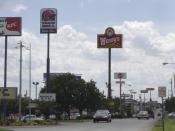Abstract
This study is to examine the effects of income and sociodemograhic factors on the household expenditure of western fast food in China. The data will be from urban household surveys conducted by the State Statistical Bureau of the People's Republic of China. Ordinary Least Square (OLS) is adopted in the regression estimation of the model
Dec 2003
Table of Content
1. Introduction
2. Research Scope and Objective
3. Literature Review
4. Theoretical and empirical model
5. Data
6. Conclusion
7. Reference
1. INTRODUCTION
Until 1980s, China's food sector and food away from home (FAFH) consumption have relatively little value added. Most Chinese prepared meals at home with grain, raw vegetables, and meat produced at home, or purchased from state-run food stores or directly from farmers. As China's rapid income growth in the last 20 years due to the reforms, Chinese consumers are eating more meals in restaurants, café and dining halls in the last two decades.
As a result, the share of consumer expenditures for food away from home (FAFH) has been increasing rapidly in urban China. The FAFH share of total food expenditures has steadily increased from 5.03% in 1992 to 14.7% at 2000. In 2000 per capita annual FAFH expenditures reached 288 yuan with the total FAFH expenditure 132 billion yuan in urban China. The FAFH expenditure growth in China is expected to continue because of the rising middle class and rapid urbanization and also due to its relatively low FAFH share compared with the USA (36.5% in 1992), Canada (32% in 1992), and other developed countires (Jensen and Yen (1996))
After long period's negotiations, China officially became the 143rd member of the World Trade Organization (WTO) in December 2001. China's accession of WTO has been a significant trade issue to the many large trade countries. China...


